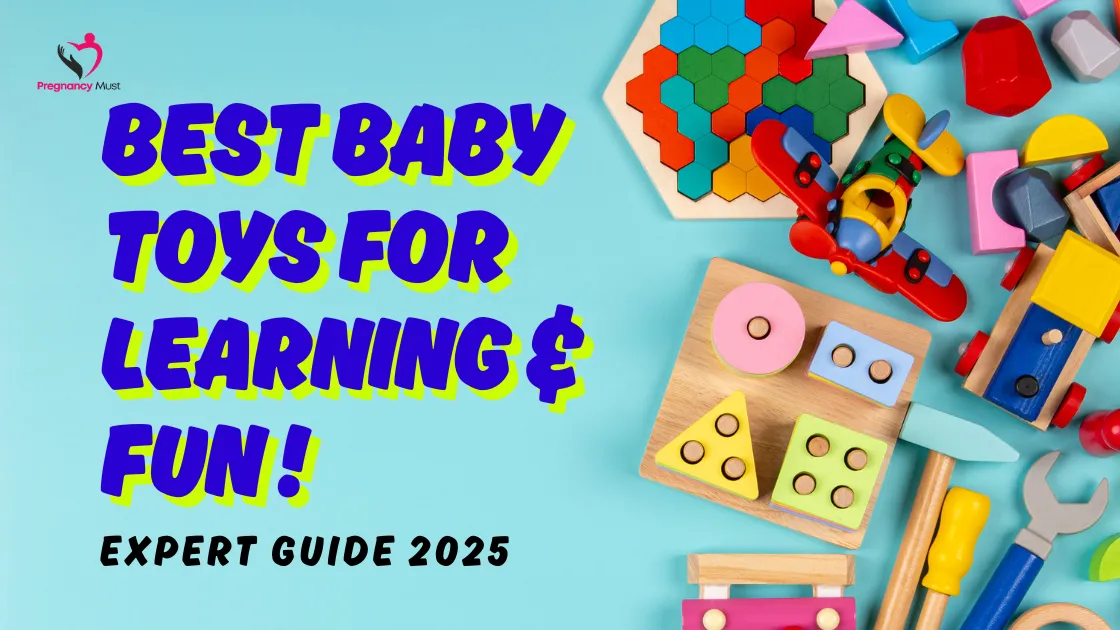Baby toys are vital growth companions in a child’s early life, not just for entertainment but for shaping how they understand the world. The toys your baby touches, holds, and engages with are often their first tools of communication, discovery, and development. In this guide, we’ll walk you through why baby toys matter, how to choose them by age, and what’s trending toys for 2025.
Table of Contents
Why Baby Toys Matter in Early Childhood
In the first few years of life, a baby’s brain forms over 1 million neural connections per second. These years are more than formative — they’re foundational. Babies learn through play, and every toy you offer serves as a part of how they learn to process information, move their own bodies, and even connect with other people.
How Baby Toys Support Development
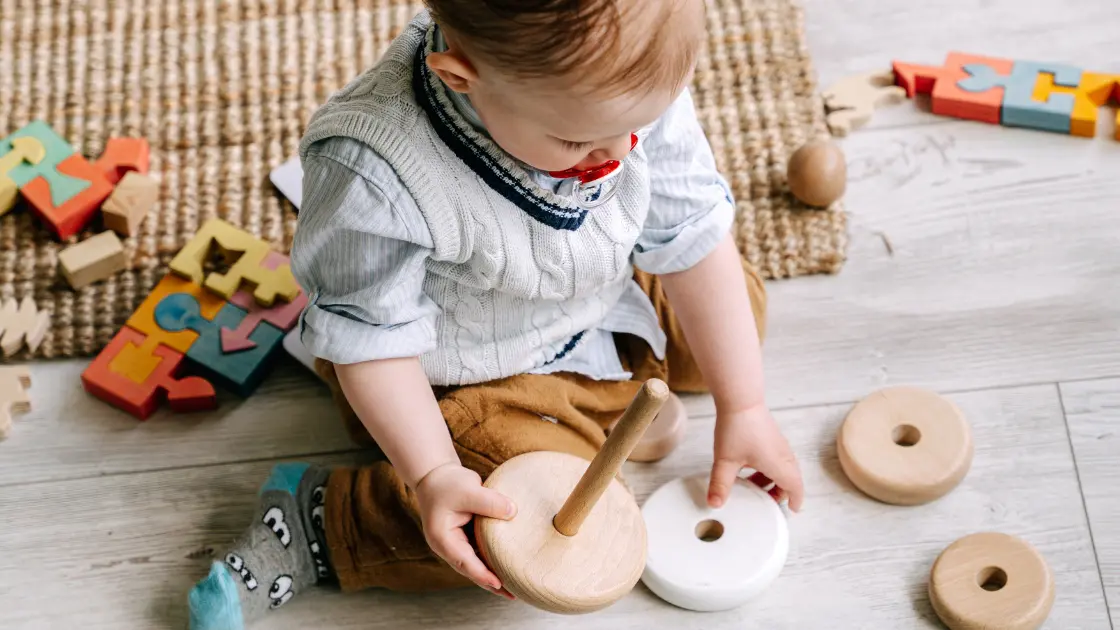
Sensory Development
Bright colors, varied textures, light, and sound help babies track and respond to sensory stimulation. This sets the tone for how they will view the world. Sensory play early in life is also great for helping to develop neural pathways that make for a happy, healthy, and well-fathered child by helping them to develop a longer attention span, a sense of curiosity, and the ability to adapt.
Motor Skills
Squeezing a softball, crawling after a toy car, or pounding the keys of a toy piano will improve coordination and build physical strength. Reaching, grasping, tugging and pushing also contribute to babies’ emerging grip strength, one of the building blocks for sitting, walking and later fine motor tasks, such as writing.
Cognitive Growth
Stacking rings, blocks, and simple puzzles are toys that exercise your baby’s memory, logic, and cause-effect knowledge. Such activities encourage your child to take his or her time to solve problems and to explore. As babies experiment through trial and error, they begin to develop the foundation of early learning practices that impact future school readiness.
Emotional Comfort
Soft plush toys, security blankets, and musical sound toys give comfort and reassurance. TThese baby toys serve as transitional objects that foster self-soothing, provide a release for stress and offer a sense of security when the child is parted from her parent or in a new and strange environment, ultimately fostering emotional resilience as the children get older.
Not Just Play – A Tool for Growth
It’s easy to underestimate the profound impact of toys on development. A rattle isn’t just a noisemaker—it teaches cause and effect. A baby toy car isn’t just a fun ride—it boosts muscle control and balance. Each toy carries with it a lesson your baby is subconsciously learning every time they play.
Top Categories of Baby Development Toys
Choosing the right toy starts with understanding what each type offers. Let’s explore the core categories that support learning and growth:
1. Sensory Toys
Sensory baby toys are suitable for all those born, newborn baby and those living with sensory processing issues.The best baby development toys to encourage baby visual development are ones with high-contrast images, instruments that make gentle sounds, materials with soft textures, as well as teething-friendly materials. These playthings are particularly beneficial during the first half of the first year when your baby’s brain is doing some serious work trying to understand the world around them.
✅ Popular Sensory Toy Examples:
- Black-and-white visual stimulation cards
- Silicone textured teething rings
- Crinkle sound books and soft rattles with varied fabric
- Light-up baby toys with gentle classical music
Why they’re important:
Babies process their world through sensation first. Sensory play is useful in building the neural pathways that become dysfunctional in the future — communication and movements. It promotes attention, exploration, and self-regulation. Sensory toys can progressively help with sensory development as babies grow and learn about their own body in space, and are able to help babies, toddlers and children of all ages learn to learn.
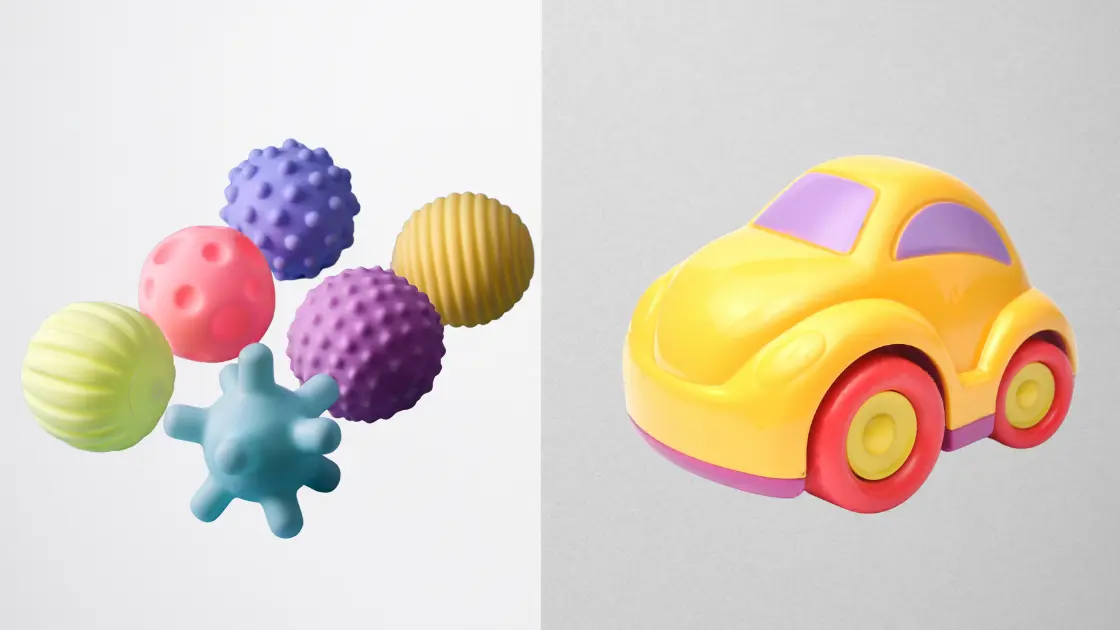
2. Motor Skill Development Toys
As babies grow, movement becomes more intentional. Baby toys that challenge them to reach, crawl, stand, and grasp help develop both fine and gross motor skills. These activities are crucial for physical development and lay the foundation for complex tasks, such as feeding oneself, writing, and participating in sports later in life.
✅ Great Motor Skill baby Toys Include:
- Push-and-go baby toy cars
- Nesting cups and stacking rings
- Baby walkers with built-in activity boards
- Shape sorters and ring stackers
These baby toys don’t just encourage movement—they build spatial awareness, hand-eye coordination, and muscular strength. Repetitive play involving movement also supports muscle memory, improves reflexes, and fosters problem-solving as babies figure out how to navigate their environment independently and confidently.
Choosing the Right Babys Toy for Each Age Stage
Babies don’t just grow fast—they grow differently at each stage. Matching baby toys with their developmental phase ensures your child is both challenged and delighted.
Newborn to 3 Months
Development Focus: Visual stimulation, hearing, and reflexive grasp
During the newborn stage, babies begin exploring the world mostly through sight and sound. Their vision is still developing, so baby toys with high-contrast patterns are the most engaging. Reflexive grasping starts to emerge, and soft textures or gentle jingling toys can hold their attention. It’s also the stage where they begin recognizing familiar voices, sounds, and simple patterns.
🔹 Best Baby Toys:
- High-contrast mobiles and mirror toys that hang over cribs or play areas
- Soft, lightweight rattles that encourage tiny hands to grip
- Sensory tag blankets or plush animals with satin edges and gentle textures
Pro Tip:
Keep baby toys simple and soothing. Babies this age may not yet reach for toys intentionally, but items that engage their eyes or ears help them build early neural connections. Even a smiling face, a soft jingle, or a gently swaying mobile can feel like a world of wonder to a newborn.
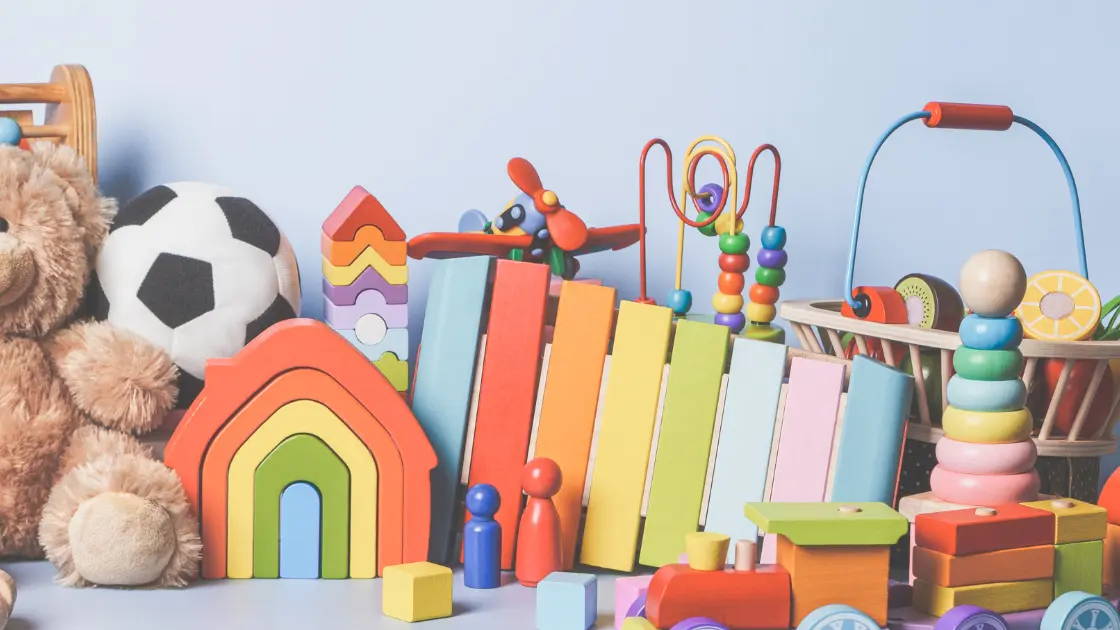
4 to 6 Months
Development Focus: Grabbing, mouthing, tummy time, rolling
By four months, babies gain more control over their movements. They begin reaching out with purpose, mouthing objects to learn textures, and engaging in longer tummy time sessions. Their neck and back muscles are strengthening, preparing them to roll over and explore independently. Baby toys during this stage should support safe exploration and encourage physical engagement.
🔹 Ideal Toys:
- BPA-free teething rings and silicone chewable shapes that ease sore gums
- Crinkle cloth books and soft blocks with different colors and touchable textures
- Tummy time water mats with floating toys that move as the baby presses on them
Why It Matters:
This stage is all about interaction. Babies love toys that respond to their actions—like squeaky soft animals or cloth books with mirrors. Such baby toys build an early understanding of cause and effect and make tummy time more enjoyable, which is essential for upper body strength and motor skill development.
7 to 12 Months
Development Focus: Crawling, pulling up, object permanence, coordination
This stage marks a huge leap in mobility and brain development. Babies begin crawling, scooting, pulling themselves up to stand, and searching for hidden objects—all signs of growing curiosity and memory. Their play becomes more hands-on and goal-oriented, and baby toys should match this new level of exploration.
🔹 Great Picks:
- Rolling baby toy cars that encourage chasing and crawling
- Activity cubes with flaps, spinners, peek-a-boo elements, and textures to discover
- Musical instruments like mini drums or xylophones that respond to taps and hits
Why It Matters:
Toys that roll light up or make music support both physical and cognitive development. Babies now enjoy toys that challenge them to explore new movements or solve simple puzzles. Interactive play, like hiding and finding objects, also introduces the concept of object permanence—an important step in memory development.
Creating a Functional Babys Toy Box
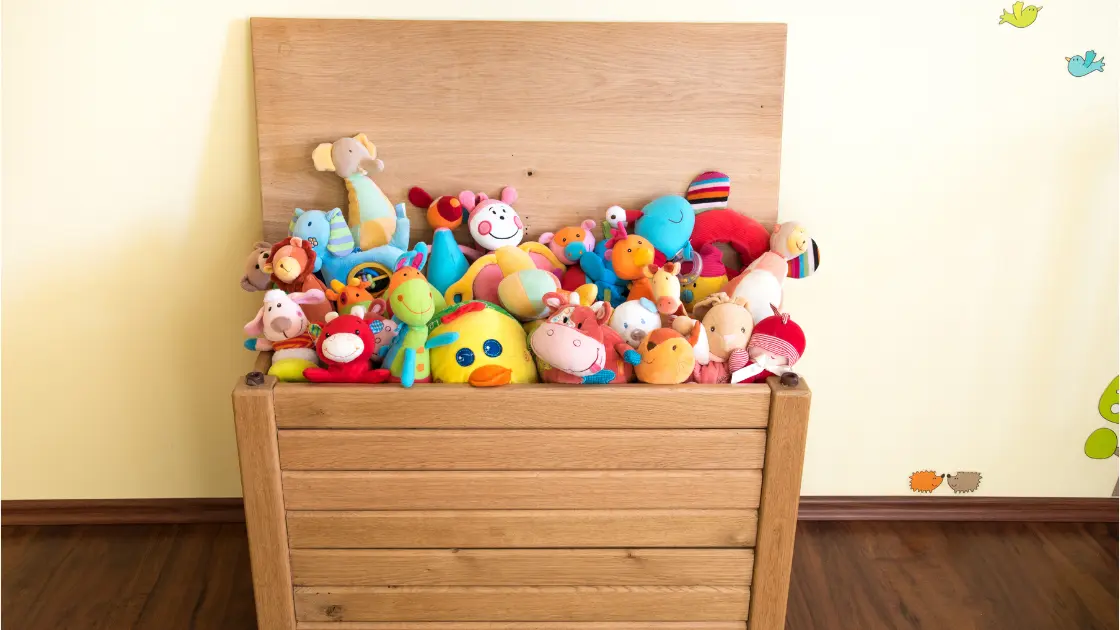
Smart Toy Box Strategies
- Organize by Type:
Use small bins or baskets within the toy box to sort baby toys into categories—sensory, motor development, and sound-making toys, for example. This helps you grab the right toy for a specific play session without rummaging through everything. It also teaches babies basic organization and helps them associate certain toys with specific play experiences.
- Rotate Weekly:
Limit visible toys to just 4–5 at a time. Every 5–7 days, switch them out with different ones from storage. This “rotation method” keeps toys feeling fresh and exciting, even if they’ve been played with before. Babies are more likely to engage with toys they haven’t seen for a few days, giving you more value from each item.
- Label for Age/Skill Level:
As a baby grows, so do his or her toy needs. Organize your bins by age range (0–3 months, 4–6 months) or skill (fine motor, gross motor, cause-effect). This helps you better match playtime to your baby’s stage of development and make sure they’re getting the right type of stimulation.
Bonus Tip:
Use clear containers with lids to keep baby toys dust-free and visible. Include a small basket next to the toy box for “favorites” that your baby reaches for daily.
Must-Include Items in a Well-Rounded Toy Box
In order to support balanced development, your baby’s toy box should have a balance of toys that target different senses and learning areas:
- A Sensory Baby Toy:
Think crinkle tag blankets, textured balls or light-up baby toys that react to touch. These engage the eyes, the ears and the fingers, promoting discovery.
- One Baby Development Toy:
Include something age-appropriate, such as a set of stacking rings, nesting cups or a shape sorter. It also promotes problem solving and fine motor skills.
- A Soft Plush or Cuddle Toy:
Whether it’s a totable stuffed animal or a lovey blanket, comfort objects give emotional comfort and continuity, which can be especially helpful during naps or tense situations.
- An Interactive Toy:
Interactive baby toys, which light up, play music or movement activated such as a toy baby car or musical ball, can promote cause and effect learning and activity.
- A High-Contrast Visual Card or Book:
Books with high-contrast patterns or baby-safe mirrors are ideal for visual development. They are most valuable in the first few months when the eyesight has not yet matured.
Why It Works
Not only does it save you time, a well-organized baby’s toy box can improve your baby’s development. When play is intentional, babies play longer, explore deeper and get more out of every interaction. This simple setup has a few benefits — it’s a solution to toy clutter, discourages overstimulation, and instills a sense of independence as baby starts ushering you to make selections from a selection of favorite toys.
Must-Have Baby’s Toys in 2025
Tech-Integrated Toys
Toys that use soft LED lights, calming white noise, motion sensors, and simple electronics are becoming smarter and more engaging. While pediatricians recommend limiting screen exposure for babies, gentle, non-screen tech can support development when used with intention. These baby toys often combine traditional play elements with sensory enhancements, helping babies stay engaged longer and learn cause and effect through safe interaction.
✅ Smart & Baby-Safe Tech Toy Ideas:
- Sleep aid plushies with heartbeat or womb sounds to calm babies at bedtime
- Crawling robots that respond to motion or sound, encouraging babies to chase and crawl
- Light-up balls that blink or change color when moved or rolled
- Interactive storybooks that play soft narration, lullabies, or nature sounds on each page
- Music cubes or panels with large baby-friendly buttons to introduce rhythm and auditory cause-and-effect
- Motion-activated mobiles that gently turn or light up when the baby stirs in the crib
- Floor projectors that display colorful light patterns during tummy time to promote visual tracking
- Touch-sensitive piano mats or kick-and-play gym toys that respond with sound to movement
Why They Work:
These baby toys bridge between traditional and digital play and provide multi-sensory stimulation to help the development of attention and early physical coordination and sensory modulation. They’re also perfect for calming rituals, tummy time play and early independence building help.
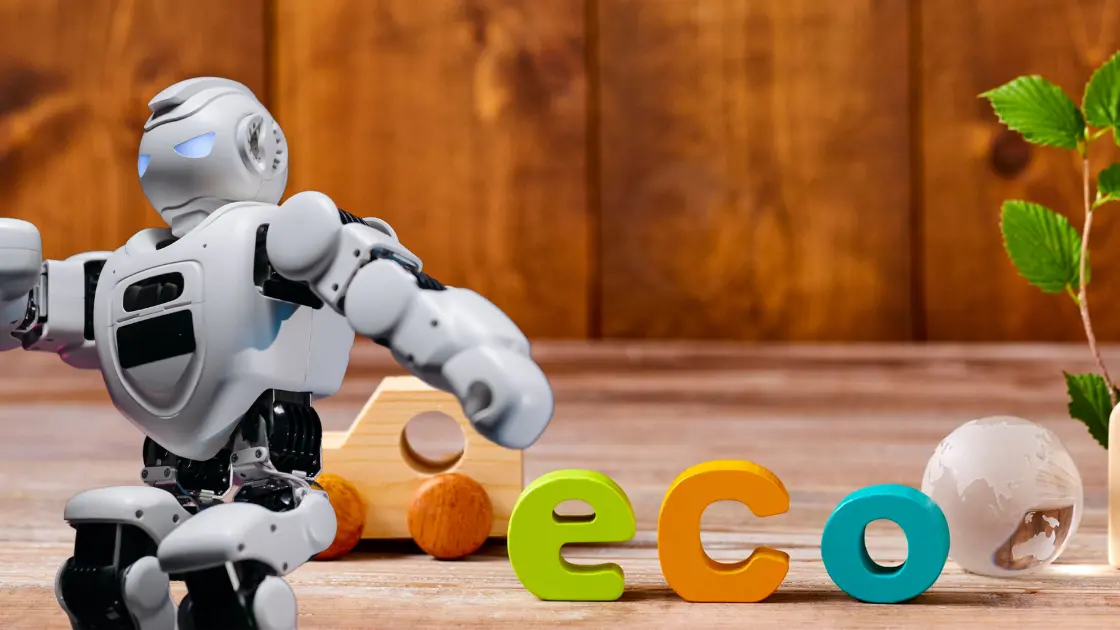
Eco-Friendly Toys
Parents are also picking baby oys that are not only safe for their babies but easy on the planet. As our culture grows in awareness of the dangers of plastic pollution and the possibility of sustainable replacements, more and more of us worry about where that baby toy came from and what it is made of. These toys are generally more durable, more chemical-free and more conscientious in terms of ethical manufacturing.
✅ Eco-Favorite Picks for Conscious Play:
- Wooden stacking rings with natural, non-toxic dyes that are safe to mouth
- Organic cotton dolls and animals with hypoallergenic stuffing
- Recycled plastic baby toy cars from trusted brands like Green Toys
- Bamboo teething rings that are naturally antibacterial and biodegradable
- Cloth sensory books made from organic muslin or hemp fabric
- Upcycled fabric blocks sewn from pre-loved textiles
- Sustainably sourced wooden puzzles with water-based paints
- Natural rubber bath toys that are mold-resistant and BPA-free
- Hand-knitted animal toys using plant-dyed wool yarn
- Eco crayon sets shaped for easy gripping and made from beeswax or soy
Why They Work:
These baby toys promote sustainability without compromising on developmental value. They’re usually more tactile, often handmade, and can be passed down or composted—making them a smart, guilt-free addition to any baby’s toy box. Plus, babies are less exposed to synthetic chemicals or artificial materials, giving parents peace of mind.
FAQ: Baby Toys – What Parents Ask the Most
Q1. When should I introduce baby toys to my newborn?
You can introduce baby toys as early as the first month. High-contrast visuals and gentle rattles work well for sensory stimulation.
Q2. What are the best baby development toys for 6-month-olds?
At 6 months, look for toys that support teething, cause-and-effect learning, and movement — like rattles, soft baby toy cars, and activity mats.
Q3. How many toys should be in a baby’s toy box?
Keep around 8–12 toys total, but only offer 4–5 at a time. Too many toys can overwhelm your baby.
Q4. Are battery-operated toys safe for babies?
Battery toys can be safe if they’re age-appropriate, sealed well, and used under supervision. Always check for loose battery compartments.
Q5. How do I clean and sanitize baby toys?
Plastic toys can be wiped with mild soap and warm water. Fabric toys should be machine-washable or sanitized with baby-safe sprays.
Q6. Are wooden toys better than plastic?
Wooden baby toys are often more sustainable and durable. However, both wood and plastic are safe if they meet safety standards.
Q7. How do I know if a toy is helping my baby’s development?
Watch for engagement signs—touching, mouthing, laughing, repeating actions. These indicate that your baby’s development toys are working!
Final Thoughts: Build a Smarter Toy Collection Today
The baby toys can be much more than just a way to keep your baby entertained; they can also be an important conduit for helping foster your baby’s developing sensory and motor skills.egin with the essentials, including sensory toys, a couple of baby toy cars, and a carefully curated baby toy box. Then, mix in educational toys that keep pace with your child.
Find more expert guidelines on Pregnancy Must –
